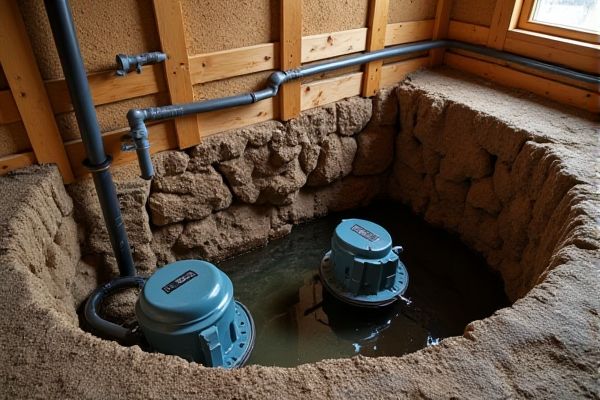
Dual sump pumps provide increased reliability by offering backup in case one pump fails, ensuring your basement remains dry during heavy rainfall or power outages, while a single sump pump may risk flooding if it malfunctions. Discover which sump pump system best safeguards your home and suits your needs by reading the rest of this article.
Table of Comparison
| Feature | Dual Sump Pumps | Single Sump Pump |
|---|---|---|
| Reliability | High - Backup pump ensures continuous operation | Moderate - No backup in case of failure |
| Cost | Higher initial and maintenance costs | Lower initial cost and maintenance |
| Capacity | Greater water removal capacity | Limited to single pump capacity |
| Installation | More complex installation process | Simple and quick installation |
| Power Dependency | Often includes battery backup options | Usually dependent on main power only |
| Maintenance | Requires maintenance of two units | Less maintenance needed |
| Ideal Use Case | Homes prone to heavy flooding or power outages | Homes with low water table and minimal flood risk |
Overview of Sump Pump Systems
A dual sump pump system provides enhanced protection by using two pumps to handle water removal, ensuring continuous operation if one pump fails, whereas a single sump pump relies solely on one unit to manage water levels. Dual systems are ideal for high-risk areas prone to heavy flooding or where prolonged pumping is necessary, offering increased reliability and peace of mind. Choosing the right system depends on your basement's water management needs and the local climate's impact on groundwater.
What Is a Single Sump Pump?
A single sump pump is a crucial device installed in your basement or crawl space that automatically removes accumulated water to prevent flooding. Designed with one pumping mechanism, it activates when water reaches a certain level in the sump pit, efficiently diverting water away from the foundation. This type of pump is ideal for homes with average water infiltration risks, providing reliable protection without the complexity of a backup system.
What Is a Dual Sump Pump Setup?
A dual sump pump setup consists of two sump pumps installed in the same sump basin to provide enhanced water removal capacity and reliability during heavy rainfall or flooding. This system typically includes a primary pump that operates under normal conditions and a secondary backup pump that activates if the primary pump fails or is overwhelmed. Your property benefits from increased protection against basement flooding and costly water damage with the added security of a dual sump pump system.
Key Differences Between Dual and Single Sump Pumps
Dual sump pumps provide enhanced reliability by operating independently, ensuring continuous water removal even if one pump fails, while single sump pumps rely on a lone unit that may risk flooding during malfunctions. Dual pumps handle higher water volumes more efficiently, making them ideal for areas with heavy water accumulation or frequent storms, whereas single pumps suffice for homes with minimal water intrusion. Your choice between dual and single sump pumps depends on the level of protection and redundancy desired for your basement or crawl space.
Efficiency and Performance Comparison
Dual sump pumps offer enhanced efficiency and performance by providing backup support during high water flow or pump failure, ensuring continuous operation. Single sump pumps may struggle to handle large volumes under heavy rain, increasing the risk of basement flooding. Choosing dual sump pumps improves reliability and prolongs the lifespan of your system by reducing strain on each pump.
Reliability and Redundancy Advantages
Dual sump pumps provide enhanced reliability by offering redundancy, ensuring continuous operation even if one pump fails. This system reduces the risk of basement flooding during heavy rain or power outages, safeguarding Your property more effectively than a single sump pump. Investing in dual pumps minimizes maintenance disruptions and increases overall system durability for long-term protection.
Installation and Maintenance Considerations
Installing dual sump pumps requires more complex wiring and a larger pit compared to a single sump pump, which typically involves straightforward setup with fewer components. Maintenance for dual pumps involves regularly testing both units to ensure redundancy and prevent failure, while a single pump demands routine checks but lacks backup reliability. You benefit from increased system reliability with dual pumps, though the initial installation and ongoing maintenance may require more time and attention.
Cost Analysis: Dual vs Single Sump Pump
Dual sump pumps typically incur higher upfront costs due to the purchase and installation of two units, but they offer increased reliability and protection against basement flooding. Single sump pumps are less expensive initially but may require costly repairs or water damage mitigation if they fail during heavy rain or power outages. Investing in a dual pump system can reduce long-term expenses by minimizing the risk of sump pump failure and subsequent property damage.
Best Applications for Each System
Dual sump pumps are ideal for homes in flood-prone areas or properties with high water tables, providing enhanced reliability by operating simultaneously or as a backup during pump failure. Single sump pumps are better suited for properties with moderate water issues and less risk of flooding, offering a cost-effective solution for routine basement drainage. Choosing the right system depends on the specific water management needs, property location, and budget considerations.
Choosing the Right Sump Pump System for Your Needs
Choosing the right sump pump system depends on factors such as the size of your basement, groundwater levels, and the risk of power outages. Dual sump pumps provide increased reliability by offering a backup pump that activates during high water volumes or primary pump failure. Single sump pumps are cost-effective and suitable for areas with moderate water levels and low flooding risk but may not provide sufficient protection in severe conditions.
 homyna.com
homyna.com